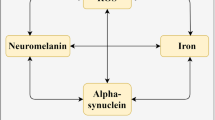Abstract
Exposure to free radicals influences synthesis, degradation and function of proteins, such as repulsive guidance molecule A. Decay of this protein is essential for neuronal maintenance and recovery. Levodopa elevates oxidative stress. Therefore levodopa may impact repulsive guidance molecule A metabolism. Objectives were to investigate plasma concentrations of repulsive guidance molecule A, levodopa, cysteine and cysteinyl-glycine before and 1 h after levodopa application in patients with Parkinson’s disease. Cysteine and cysteinyl-glycine as biomarkers for oxidative stress exposure decreased, repulsive guidance molecule A and levodopa rose. Repulsive guidance molecule A remained unchanged in levodopa naïve patients, but particularly went up in patients on a prior chronic levodopa regimen. Decay of cysteine specifically cysteinyl-glycine results from an elevated glutathione generation with rising cysteine consumption respectively from the alternative glutathione transformation to its oxidized form glutathione disulfide after free radical scavenging. Repulsive guidance molecule A rise may inhibit physiologic mechanisms for neuronal survival.



Similar content being viewed by others
References
Allen GF, Ullah Y, Hargreaves IP, Land JM, Heales SJ (2013) Dopamine but not l-dopa stimulates neural glutathione metabolism. Potential implications for Parkinson’s and other dopamine deficiency states. Neurochem Int 62:684–694
Antonini A, Bondiolotti G, Natuzzi F, Bareggi SR (2010) Levodopa and 3-OMD levels in Parkinson patients treated with Duodopa. Eur Neuropsychopharmacol 20:683–687
Demicheva E, Cui YF, Bardwell P, Barghorn S, Kron M, Meyer AH, Schmidt M, Gerlach B, Leddy M, Barlow E, O’Connor E, Choi CH, Huang L, Veldman GM, Rus H, Shabanzadeh AP, Tassew NG, Monnier PP, Muller T, Calabresi PA, Schoemaker H, Mueller BK (2015) Targeting repulsive guidance molecule A to promote regeneration and neuroprotection in multiple sclerosis. Cell Rep 10:1887–1898
Doya H, Ito T, Hata K, Fujitani M, Ohtori S, Saito-Watanabe T, Moriya H, Takahashi K, Kubo T, Yamashita T (2006) Induction of repulsive guidance molecule in neurons following sciatic nerve injury. J Chem Neuroanat 32:74–77
Hata K, Fujitani M, Yasuda Y, Doya H, Saito T, Yamagishi S, Mueller BK, Yamashita T (2006) RGMa inhibition promotes axonal growth and recovery after spinal cord injury. J Cell Biol 173:47–58
Jugel C, Ehlen F, Taskin B, Marzinzik F, Müller T, Klostermann F (2013) Neuropathy in Parkinson’s disease patients with intestinal levodopa infusion versus oral drugs. PLoS One 8:e66639
Key B, Lah GJ (2012) Repulsive guidance molecule A (RGMa): a molecule for all seasons. Cell Adh Migr 6:85–90
Koeberle PD, Tura A, Tassew NG, Schlichter LC, Monnier PP (2010) The repulsive guidance molecule, RGMa, promotes retinal ganglion cell survival in vitro and in vivo. Neuroscience 169:495–504
Liedhegner EA, Steller KM, Mieyal JJ (2011) Levodopa activates apoptosis signaling kinase 1 (ASK1) and promotes apoptosis in a neuronal model: implications for the treatment of Parkinson’s disease. Chem Res Toxicol 24:1644–1652
Maguire-Zeiss KA, Short DW, Federoff HJ (2005) Synuclein, dopamine and oxidative stress: co-conspirators in Parkinson’s disease? Brain Res Mol Brain Res 134:18–23
Müller T (2013) Detoxification and antioxidative therapy for levodopa-induced neurodegeneration in Parkinson’s disease. Expert Rev Neurother 13:707–718
Müller T, Muhlack S (2011) Cysteinyl-glycine reduction as marker for levodopa-induced oxidative stress in Parkinson’s disease patients. Mov Disord 26:543–546
Müller T, Muhlack S (2014) Levodopa-related cysteinyl-glycine and cysteine reduction with and without catechol-O-methyltransferase inhibition in Parkinson’s disease patients. J Neural Transm 121:643–648
Müller T, Erdmann C, Muhlack S, Bremen D, Przuntek H, Goetze O, Woitalla D (2006) Pharmacokinetic behaviour of levodopa and 3-O-methyldopa after repeat administration of levodopa/carbidopa with and without entacapone in patients with Parkinson’s disease. J Neural Transm 113:1441–1448
Müller T, Jugel C, Ehret R, Ebersbach G, Bengel G, Muhlack S, Klostermann F (2011) Elevation of total homocysteine levels in patients with Parkinson’s disease treated with duodenal levodopa/carbidopa gel. J Neural Transm 118:1329–1333
Müller T, Jugel C, Muhlack S, Klostermann F (2013) Methyl group-donating vitamins elevate 3-O-methyldopa in patients with Parkinson disease. Clin Neuropharmacol 36:52–54
Müller T, Barghorn S, Luetge S, Haas T, Mueller R, Gerlach B, Ohm G, Eilert K, Trommer I, Mueller BK (2015) Decreased levels of repulsive guidance molecule A in association with beneficial effects of repeated intrathecal triamcinolone acetonide application in progressive multiple sclerosis patients. J Neural Transm 122:841–848
Parkinson Study Group (2002) Dopamine transporter brain imaging to assess the effects of pramipexole vs levodopa on Parkinson disease progression. JAMA 287:1653–1661
Riederer P, Lachenmayer L, Laux G (2004) Clinical applications of MAO-inhibitors. Curr Med Chem 11:2033–2043
Sabens EA, Distler AM, Mieyal JJ (2010) Levodopa deactivates enzymes that regulate thiol-disulfide homeostasis and promotes neuronal cell death—implications for therapy of Parkinson’s disease. Biochemistry 49:2715–2724
Schwab JM, Conrad S, Monnier PP, Julien S, Mueller BK, Schluesener HJ (2005) Spinal cord injury-induced lesional expression of the repulsive guidance molecule (RGM). Eur J Neurosci 21:1569–1576
Shabanzadeh AP, Tassew NG, Szydlowska K, Tymianski M, Banerjee P, Vigouroux RJ, Eubanks JH, Huang L, Geraerts M, Koeberle PD, Mueller BK, Monnier PP (2015) Uncoupling Neogenin association with lipid rafts promotes neuronal survival and functional recovery after stroke. Cell Death Dis 6:e1744
Smeyne M, Smeyne RJ (2013) Glutathione metabolism and Parkinson’s disease. Free Radic Biol Med 62:13–25
Tao T, Xu G, Si CC, Feng J, Kong Y, Qin X (2013) Minocycline promotes axonal regeneration through suppression of RGMa in rat MCAO/reperfusion model. Synapse 67:189–198
Whone AL, Watts RL, Stoessl AJ, Davis M, Reske S, Nahmias C, Lang AE, Rascol O, Ribeiro MJ, Remy P, Poewe WH, Hauser RA, Brooks DJ (2003) Slower progression of Parkinson’s disease with ropinirole versus levodopa: the REAL-PET study. Ann Neurol 54:93–101
Zeevalk GD, Razmpour R, Bernard LP (2008) Glutathione and Parkinson’s disease: is this the elephant in the room? Biomed Pharmacother 62:236–249
Acknowledgments
We thank Tanja Steiner, Christine Stamm, Ulrike Beckmann, Marion Frickmann, Christa Kraushaar-Szesni for technical assistance. We thank the participating PD patients.
Author information
Authors and Affiliations
Corresponding author
Rights and permissions
About this article
Cite this article
Müller, T., Trommer, I., Muhlack, S. et al. Levodopa increases oxidative stress and repulsive guidance molecule A levels: a pilot study in patients with Parkinson’s disease. J Neural Transm 123, 401–406 (2016). https://doi.org/10.1007/s00702-016-1519-4
Received:
Accepted:
Published:
Issue Date:
DOI: https://doi.org/10.1007/s00702-016-1519-4




